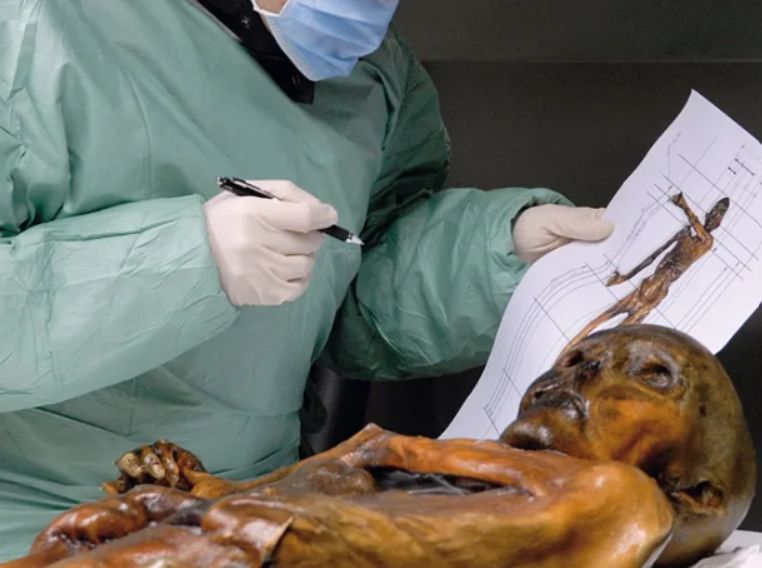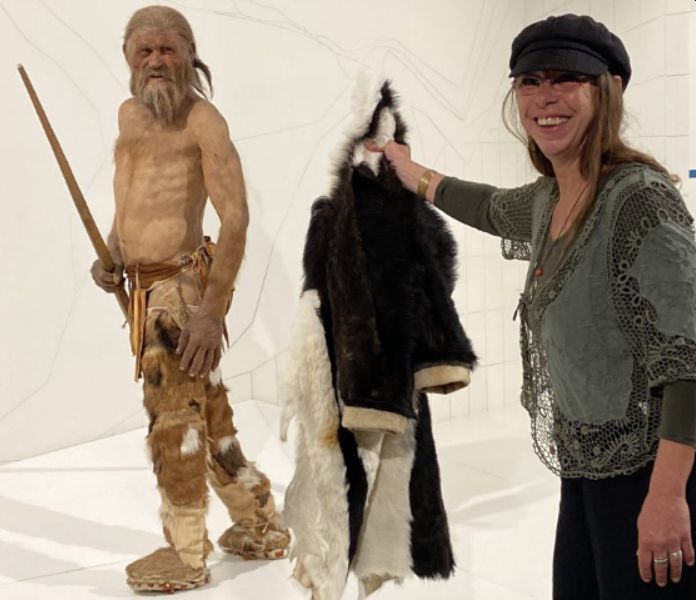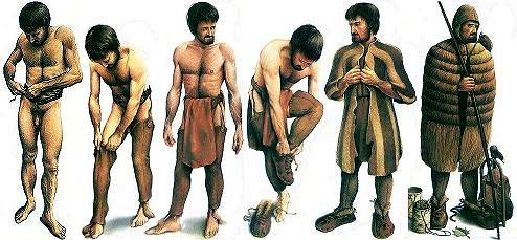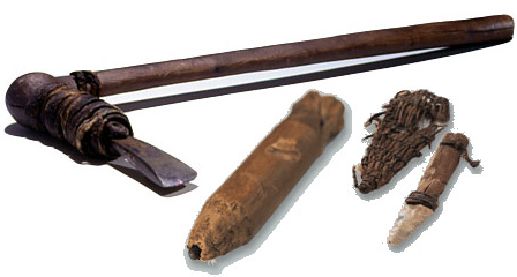By Eric Vandenbroeck and co-workers
Ötzi The Iceman
It was at first
believed that the Iceman was free of diseases, but in 2007 researchers
discovered that his body had been infested with whipworm and that he had
suffered from arthritis; neither of these conditions contributed to his death.
He also, at one time, had broken his nose and several ribs. His few remaining
scalp hairs provide the earliest archaeological evidence of haircutting, and
short blue lines on his skin (lower spine, left leg, and right ankle) have been
variously interpreted as the earliest known tattoos or as scars remaining from
a Neolithic therapeutic procedure.
The various clothes
and accouterments found with him are truly remarkable since they formed the
gear of a Neolithic traveler. The Iceman’s basic piece of clothing was an
unlined fur robe stitched together from pieces of ibex, chamois, and deer skin.
A woven grass cape and a furry cap provided additional protection from the
cold, and he wore shoes made of leather and stuffed with grass. The Iceman was
equipped with a small copper-bladed ax and a flint dagger, both with wooden
handles; 14 arrows made of viburnum and dogwood, two of which had flint points
and feathers; a fur arrow quiver and a bow made of yew; a grass net that may
have served as a sack; a leather pouch; and a U-shaped wooden frame that served
as a backpack to carry this gear. His scant food supply consisted of sloe
berries, mushrooms, and a few gnawed ibex bones.
Ötzi
the Iceman, named after the valley in which he was found, became world-famous
because his body had been remarkably well preserved by the intense cold,
making him the oldest European mummified human. Scientists began examining Ötzi, and soon a startling series of discoveries emerged.
Dark eyes, receding
black hair, few or no freckles, and a darker skin tone. This is how Ötzi the iceman, the mummified corpse found trapped in the
ice of the Italian Alps, would have looked while living.
Researchers who
conducted a higher-coverage genome analysis to learn more about Ötzi’s genetic history and the mummified man’s physical
appearance have found genes associated with male-pattern baldness and darker
skin tone. It is the darkest skin tone recorded in contemporary European individuals
meaning the Caucasian look appears to be a more recent development with earlier
a sort of 'out of Africa' skin color.
Ötzi’s genomes were first sequenced in 2012. That analysis
resulted in traits of a light-skinned, light-eyed hairy male in contrast to the
current findings, which the development of DNA sequencing technology has
helped. Sequencing technology has advanced, allowing researchers to generate a
high-coverage genome with more accurate analysis. This allowed them to gain new
information and correct earlier findings.
The study indicates
that Ötzi had a dark-skinned complexion during his
lifetime, an idea supported by a previous analysis of Ötzi’s
skin that found brown melanin granules in the deepest layer of the epidermis.
The recent findings also dispute the previously thought ancestry of the iceman.
Research revealed that the iceman had many genes in common with the early
farmers from Anatolia.

There were also no
traces of eastern European Steppe herders. The proportion of hunter-gatherer
genes in Ötzi’s genome is very low.
Ötzi
and Meridians?
A team of European
researchers has analyzed the tattoos scattered across Ötzi’s
body and the various herbs and medicines found alongside his remains to paint a
clearer picture of the Iceman’s community and its ancient medical practices,
reports Joshua Rapp Learn for Science magazine. The scientists’ findings, newly published in
the International
Journal of Paleopathology,
suggest Ötzi belonged to a society with a
surprisingly advanced healthcare system.
Previous studies of
the Iceman’s tattoos have hypothesized that the lines and crosses etched into
his skin offered therapeutic benefits rather than simply serving as decorative
embellishments. Ancient Origins’ April Holloway writes that the tattoos,
created via small incisions traced with charcoal, align with “hard-working
areas of the human body,” including the ankles, wrists, knees, and lower back.
These spots are commonly associated with acupuncture treatments, raising the
possibility that Ötzi’s community knew of the
practice some 2,000 years before it was believed to have first emerged in Asia.
Archaeologists
initially mapped Ötzi’s 61 inkings
in 2015, Carl Engelking reports for Discover magazine. Before this examination, researchers thought the
Iceman’s tattoos numbered closer to 59. Multispectral imaging analysis revealed
a set of previously unidentified tattoos clustered on the Iceman’s chest,
an area commonly associated with acupuncture points
targeting intestinal disorders.

The new study draws
on this existing body
of knowledge to
argue that Ötzi’s tattoos required “considerable
effort … and, irrespective of the efficacy of the treatment, provided care for
the Iceman.” The authors further stipulate that if Ötzi’s
peers developed acupuncture, they must have undergone an extended trial and
error spurred by the desire and ability to develop medical practices.
Plants in the
Iceman’s belongings support the study’s portrait of an inquisitive, complex
society. Birch polypore fungus tied to the leather bands of Ötzi’s
tools may have calmed inflammation or act as an antibiotic, Science’s
Rapp Learn notes, while bracken fern detected in his stomach could have served
as a tapeworm treatment. Traces of bog moss mirror makeshift bandages.
Given the
sophisticated set of tools Ötzi wielded and the
“intentional design elements” apparent in his clothing, it’s not a stretch to
emphasize craftsmanship to the Copper Age community’s medical practices.
Previous studies have
found that Ötzi carried several suspected medicines
either on him or in him. Fastened to leather bands in his equipment,
researchers found the birch polypore fungus, which the Iceman may have used to
calm inflammation or as an antibiotic. Scientists also found a bracken fern in
his stomach, which can be used to treat intestinal parasites such as tapeworms.
And Ötzi was covered with 61 tattoos (such as the one
on his back, pictured above), including dotlike points around joints.
There is evidence of
quite detailed attention to the preparation of clothing with which to dress
against the cold:

And evidence of a
sophisticated range of tools:

In the new study,
scientists looked closer at Ötzi's tattoos. Some
lines and dots were directly over his wrist and ankles, which suffered from
degenerative diseases, and many
correspond to traditional acupuncture points, they report in the International Journal of
Paleopathology. The markings would have taken a long time to produce, and
this sophisticated practice—along with the variety of herbs and medicines—would
have likely been developed through a dedicated, systematic trial-and-error
approach that was passed down through generations in the society in which Ötzi lived, the team concludes.
All of this—combined
with the sophisticated use of plants and fungi to treat ailments—suggests Ötzi was part of a culture with some knowledge of anatomy,
how diseases arise, and how to treat them, the scientists say. What they don't
know is whether any of these treatments worked.
For updates click hompage here